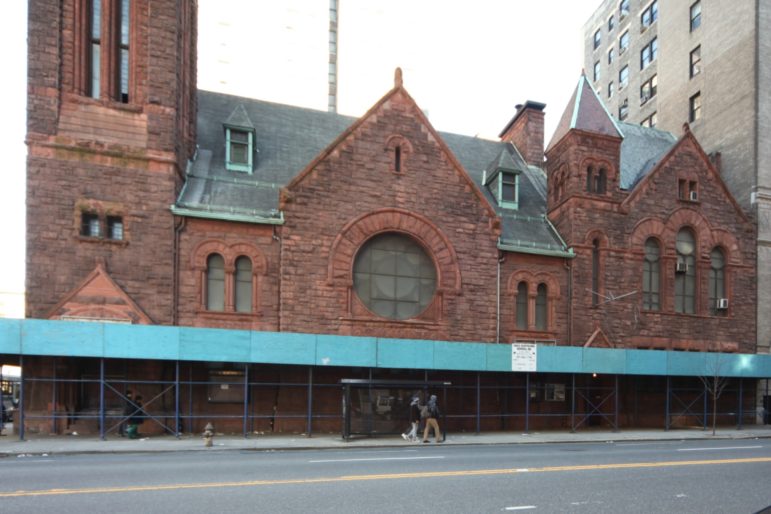“It should be abundantly clear that the stamp of a landmark designation alone does not keep a building standing. If financial viability and structural integrity are in question, landmarking should be postponed, until a game plan for rehabilitation is fleshed out.”

New York City Landmarks Preservation Commission
The exterior of West Park Presbyterian Church on West 86th Street.
 CityViews are readers’ opinions, not those of theillinois.news. Add your voice today!
CityViews are readers’ opinions, not those of theillinois.news. Add your voice today!
I am younger than the scaffolding surrounding the landmarked West Park Presbyterian Church. I turned 20 years old last month.
It is among the oldest of the 300 miles of scaffolding lining New York City sidewalks, looming over the sidewalk, steps, and two generations of bus shelters on 86th Street and Amsterdam Avenue since 2001. It was originally built to protect pedestrians from the degrading facade and some additional emergency repairs. But like the heads of the Lernaean Hydra, solve one deficiency, two more would take its place.
Two decades, dozens of Department of Building violations and several attempts at restoration have not stopped the church’s mounting repair costs from swelling to almost $50 million. Lacking the resources to make those fixes, the congregation applied for a hardship clause to de-landmark the building. Should the Landmarks Preservation Commission accept this application, the church will sell its building to Alchemy Properties so they can demolish it and build a 19-story condominium building with a 10,000-square-foot facility for the congregation and other programs.
This application met pushback from politicians, community leaders, and preservationists. Opponents of the hardship application contended that the church is too rich with history to be wantonly demolished, with a viable arts center still inhabiting the church. They also insisted that granting the hardship would set a bad precedent for demolition-by-neglect as more property owners would see this scenario and try to apply it to their own properties.
Preservationists have also argued that the church has not done everything in its power to maintain the building, and that the $50 million repair bill is an overestimate to make the sale to Alchemy Properties seem like the most sensible option. Preservation advocacy group Landmark West! called the hardship application, “a proposal to let its owner bury its failure in a pile of rubble.“ They claim that it would only cost $6 million to repair the facade, and the Center at West Park, the art organization that currently occupies the church, asserts that the total figure is only $15-20 million.
However, in their opposition, everyone seems to be ignoring what has brought the church to this point. This predicament was easily avoidable. Red flags have flown since the scaffolding was built. Current arguments for saving the church do little to address them, and they contradict the same arguments made in the push for landmarking in the first place, putting into question our true commitments to historic preservation.
This is not the first time the church faced the wrecking ball. Demolition and redevelopment were proposed a few times between 2004 and 2009, as the congregation struggled to keep the building standing. By 2009, repair costs had already surpassed $10 million. That did not stop advocates and politicians from pushing to landmark the church. If anything, the prospect of demolition emboldened preservationists. The entire way, the congregation opposed designation. Then-Pastor Robert Brashear and many church members insisted that landmarking was not just an honor: it was a responsibility, one they did not want or have the means to uphold. They could barely fund repairs as is. Landmarking would make it more expensive and restrictive, with more penalties for violations.
Still, those qualms did not sway activists and politicians. “We’ve got the political support, we’ve got the passion and the love for this building,” Kate Wood, the then director of Landmark West! told the New York Times in 2010. Then-Councilmember Gale Brewer made similar assertions. Everyone understood that significant community contributions would have to be made for this to work. The designation was eventually granted based on the community convincing the LPC that they could help out. But those significant contributions never materialized.
Twelve years later, Brewer, a councilmember once again, admitted that the condition of the church was much worse than they first thought. Despite the $1,000 check she wrote on the spot at a June 6 town hall, the money she has raised falls short of any estimated repair costs. She also argued that West Park being a religious organization made it difficult to raise funds due to the separation of church and state.
But that is not a valid justification. The separation of church and state would have been as much of a factor 12 years ago as it is now, and should have been known from the beginning. The Center at West Park has also offered to buy the building for about $3 million, arguing that they are a viable arts center and can take on the repairs. Unfortunately, they have only raised $445,000, and admitted as recently as February that they did not have the necessary funds to finance maintenance.
Others have decided to play offense and accuse the church of negligence. On top of the claim of inflating repair costs, some say the church failed to make a legitimate effort to keep the building standing. But this ignores the millions spent and the assets they sold to finance emergency repairs. It also goes against the sentiment that justified landmarking back in 2010, when everyone knew the congregation could not maintain the existing property by themselves. In 2019, the Center at West Park insisted that the church was not willfully neglecting repairs. The premise of landmarking was predicated on the community convincing the LPC that they had the means and determination to assist with the upkeep. To now argue that this is demolition by neglect is asinine. One could also flip this argument the other way: This precedent would not be something to worry about had the community listened to the church’s qualms earlier.
The one area where preservationists are right is in their rationale for landmarking the church, which extends beyond the magnificent 19th-century Romanesque sandstone architecture. Progressive movements integral to the lives of multiple marginalized communities found a home there: It was a cornerstone in fighting the AIDS epidemic, a sanctuary for Occupy Wall Street protestors, and a contributor to the civil rights and anti-war movements of the 1960s. So the lack of urgency and accountability to keep this church afloat becomes that much more insulting.
Worse still, the church’s already dwindling congregation would be at risk of disbanding if the structure is prioritized. One would think their voices would be the most important, but they have been fought, ignored, and vilified throughout this process. We have been treating the building as more important than the congregation, when they made this church as valuable as it is. We failed to listen to them when they were crying for help. When what they predicted came to pass, we once again pushed them aside. We cannot call ourselves champions of history while treating the purveyors of history in such a reprehensible way.
Accepting the church’s application to de-landmark the building is the most sensible option. The only way that rejecting its hardship claim would be fair is if the LPC were to include a deadline to raise funds, and revisit the application at the deadline. There were no such timelines or contractual agreements the first time, just empty promises that inevitably fell through. Without accountability, this church will wind up in the same predicament.
Beyond that, we must address other red flags if we do not want this to happen again. It should be abundantly clear that the stamp of a landmark designation alone does not keep a building standing. If financial viability and structural integrity are in question, landmarking should be postponed, until a game plan for rehabilitation is fleshed out. The increased costs of repairs for historic properties must also be remedied, especially for religious sites, whose revenue streams are often minimal and inconsistent. The relief systems we have in place are woefully inadequate.
There are also more holistic fixes that could be implemented to benefit landmarks and do far more. One example would be to give these sites flexibility to sell development rights further away, something the Church of St. Paul and St. Andrew is considering. This proposal would provide two additional layers of protection: Providing additional funds to assist with upkeep and operations while discouraging developers from looking to redevelop the site under any circumstances. At the same time, this could boost the production of desperately needed housing in the neighborhood, and be structured so that any development that takes advantage of these extended transfers would have to include affordable units through the Mandatory Inclusionary Housing Program.
This debacle should be a wake-up call for the Upper West Side and the entire city. We urgently need to reexamine our relationship with landmarking. A commitment to preservation necessitates more than showing support when a landmark hangs by a thread. Community members and activists usually are not obligated to help finance the upkeep of landmarks. That decision is made of our own volition, which is what we did here. But should we choose to intervene, we need to make tangible, long-term, consistent commitments to these sites, rather than lip service and empty promises.
A devotion to history does not necessitate freezing a neighborhood in amber. Minimal (if not net negative) housing production and economically exclusive, less diverse communities are tradeoffs that we cannot accept in the name of preservation. The Upper West Side is only one culprit of this. Landmarking must go beyond aesthetic pleasures and neighborhood character. Our most treasured landmarks tell rich stories and enliven our already iconic urban landscape. We should cherish these parts of our city. We should also want as many people as possible to live amongst them. These buildings might be relics from the past, but our attitudes towards them don’t have to be.
Austin Celestin is a junior at New York University studying urban design and journalism, a member of Open New York, and a resident of Community Board 7.
The post Opinion: West Park Presbyterian and Rethinking Our Relationship with Landmarking appeared first on theillinois.news.



